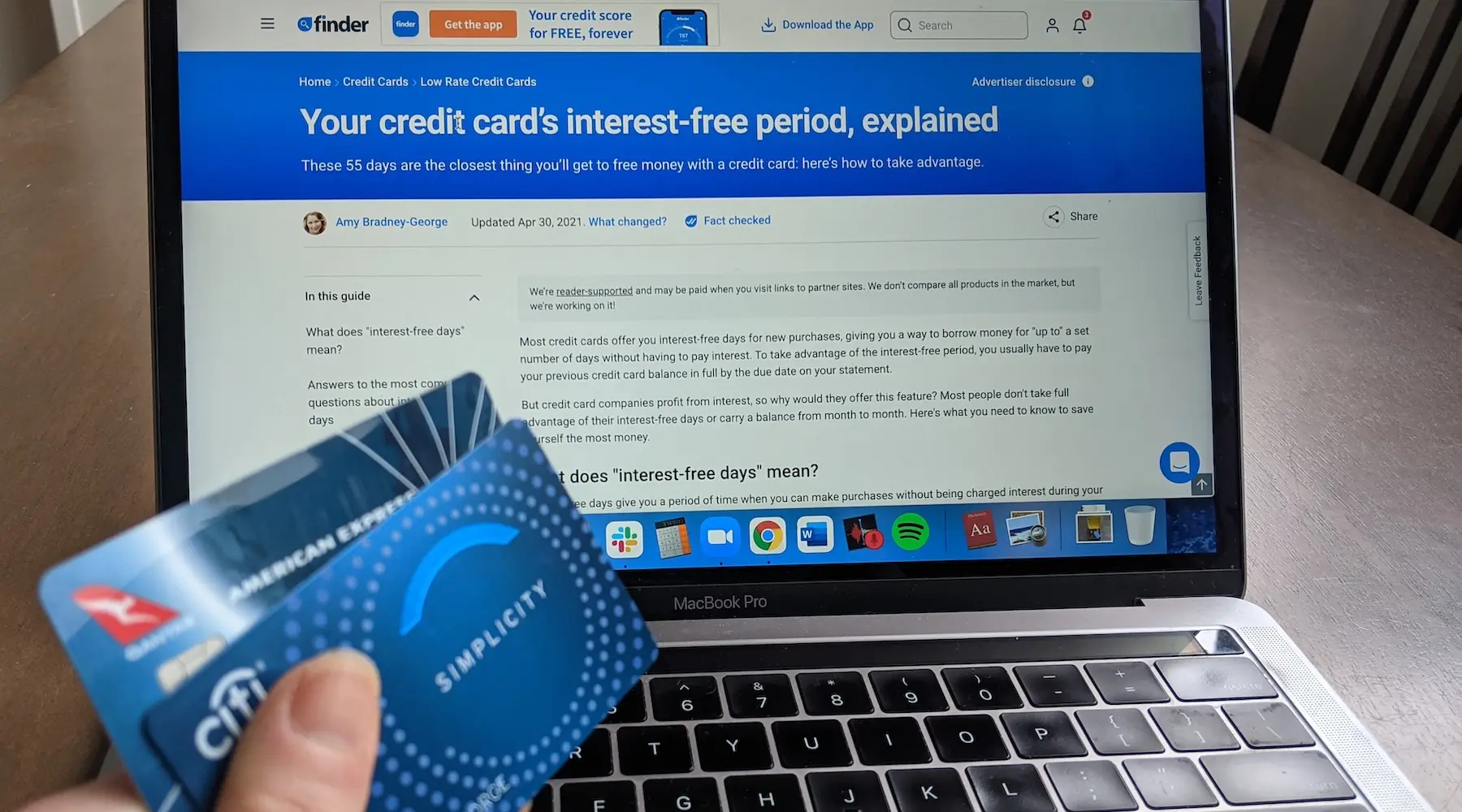In 9 years I’ve never paid credit card interest – here’s how

I've had 4 credit cards, earned a lot of points and used perks without ever paying a cent in interest – and you can too.
Like most people, I've heard stories of huge credit card debts that took people years to pay off and cost a small fortune.
When I decided to apply for my first card, I was working on a freelance basis and had unpredictable paydays. So I thought a credit card would help me cover some of my bigger costs, such as the new computer I needed or interstate flights to see my family.
Almost a decade later, I never thought I would have come this far without ever paying interest on any of my credit cards.
So how have I never paid any interest? The answer is a common but little-understood credit card feature known as interest-free days.
How to use interest-free days to pay $0 interest
In basic terms, interest-free days let you make purchases without paying interest for a window of time.
That timeframe is usually 44 or 55 days from the start of the statement period and ends on the due date for your next payment. With most cards, you have to pay your whole balance off by this due date to get the interest-free period.
If it sounds confusing, don't worry – I've found it's easier to use than to explain.
Basically it means if you pay off what you spend by the due date on your statement, you won't be charged interest. (Unless you use your card for cash advance transactions, but that's another story).
As an example, let's say you have a credit card with up to 55 days interest-free on purchases and the following details:
- Statement period: 1-30 September. This is the time when you can use the card to pay for things. So, let's say you spend $1,000 over this period.
- Payment due date: 25 October. The due date is shown on your monthly statement, which you would get after 30 September.
- Interest-free period: This runs from 1 September to 25 October, giving you "up to 55 days interest-free" on purchases.
In this example, as long as you paid back the full $1,000 by 25 October, you would pay $0 interest.
How much could you save?
When I got my first credit card, the standard average credit card interest rate was 19.59%. Right now it's 19.94%, so it really hasn't changed much – despite the Reserve Bank of Australia's official cash rate dropping by record amounts across the same time.
Finder analysis also shows the average credit card balance accruing interest is $1,487. So, if someone was only making monthly repayments of $50 on a card with a 19.94% p.a. interest rate, it would take 3.45 years to pay off and cost a total of $580.91 in interest.
That works out to roughly $168.38 in interest every year. Based on these averages, I've saved around $1,515.42 in the past 9 years. And that's just for one card.
My strategy to make sure I never pay interest
If you're keen to follow in my footsteps, it's actually pretty easy. Here's a breakdown of what I do to make sure my credit card spending never costs me interest:
- Shop with my card
- Check the balance every week so I know what I've spent
- Pay off my spending as I go, such as weekly
OR - Pay off everything when I get my statement, once a month
I tend to go between these two ways of paying off my credit cards. But which one I use often boils down to one of the following goals:
When I want peace of mind: I'll pay things off as I go. For example, a few weeks ago I used my card to buy some gym gear and paid it off a few days later. I often do this with my frequent flyer credit card so I can earn points without worrying about overspending.
When I want simplicity: I'll wait for the credit card statement, then pay off everything that's owed a few days before the due date. I actually did that for my other credit card last week.
Either way, I get around 30 days interest-free, because I pay off my credit card when I get my statement (or sooner).
What if you want to get the maximum amount of interest free days?
If you want to make the most of the total number of interest-free days on your card, for example "up to 55", pay attention to the due date on your statement. Remember:
- An interest-free period of 55 days would apply to purchases made on day 1 of your statement period, for example 1 September.
- Then, 54 days interest-free would apply to purchases made on day 2, for example 2 September.
- By the end of the month, any purchases made on the last day of your statement period, in this case 30 September, now have 25 days before the payment is due, which makes up the remaining 25 days interest-free.
To put it another way: On a card with up to 55 days interest-free, you'd have around 30 days to spend money interest-free before you get your statement. You'd then have around 25 days to pay off what you spent without interest.

For me, the approach I take is similar to how I use my everyday accounts. So it's easy to keep on top of my credit card spending and payments.
But I know some people who hardly ever check their credit card account and just pay off the whole balance by the due date on each statement. (If that's your style, you could even set up automatic payments for the account, similar to direct debits, so you never pay any interest).
An added bonus: I can see all the positive payment information reflected on my credit report and credit score – which is "excellent".
What if you can't pay off the whole balance each month?
The reality is some people use credit to get by and when the due date arrives, you may not have enough money to pay off the balance in full.
If that's the case, interest-free days usually won't be much help to you, as you need to be able to pay the full balance due in order to avoid paying interest altogether.
For example, if the balance due is $5,000 and you repay $3,000, then you'll still pay interest on the difference of $2,000.
In this situation, you'd be better off looking at a low rate credit card, or maybe one that has no interest and charges a monthly fee instead. This allows you to manage your spending and repayments, without the risk of paying a premium on credit card purchases, in the form of interest.
Want to get a credit card that actually works for you? Compare a mix of cards or take our easy quiz to help you find one that suits you.
Images: Getty Images, Finder (Luke Dubbelde, Amy Bradney-George)
Ask a question
